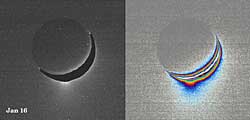|
COMETS EARTH JUPITER KUIPER BELT MARS MERCURY METEORITES NEPTUNE OORT CLOUD PLUTO SATURN SOLAR SYSTEM SPACE SUN URANUS VENUS ORDER PRINTS
PHOTO CATEGORIES SCIENCEVIEWS AMERICAN INDIAN AMPHIBIANS BIRDS BUGS FINE ART FOSSILS THE ISLANDS HISTORICAL PHOTOS MAMMALS OTHER PARKS PLANTS RELIGIOUS REPTILES SCIENCEVIEWS PRINTS
|
Related Documents
Download Options
A fine spray of small, icy particles emanating from the warm, geologically unique province surrounding the south pole of Saturn's moon Enceladus was observed in a Cassini narrow-angle camera image of the crescent moon taken on Jan. 16, 2005. Taken from a high phase angle of 148 degrees - a viewing geometry in which small particles become much easier to see - the plume of material becomes more apparent in images processed to enhance faint signals. Imaging scientists have measured the light scattered by the plume's particles to determine their abundance and fall-off with height. Though the measurements of particle abundance are more certain within 100 kilometers (60 miles) of the surface, the values measured there are roughly consistent with the abundance of water ice particles made by other Cassini instruments (reported in September 2005) at altitudes as high as 400 kilometers (250 miles) above the surface. At present, it is not clear if the plume particles emanating from the south pole arises because of water vapor escaping from warm ice that is exposed to the surface. Another possibility is that at some depth beneath the surface, the temperatures are hot enough for water to become liquid, which then, under pressure, escapes to the surface like a cold Yellowstone geyser. The image at the left was taken in visible green light. A dark mask was applied to the moon's bright limb to make the plume feature easier to see. The image at the right has been color-coded to make faint signals in the plume more apparent. Images of other moons, such as Tethys and Mimas, taken in the last 10 months from similar lighting and viewing geometries, and with identical camera parameters, were closely examined to demonstrate that the plume towering above Enceladus' south pole is real and not a camera artifact. The images were acquired at a distance of about 209,400 kilometers (130,100 miles) from Enceladus. Image scale is about 1 kilometer (0.6 mile) per pixel. |
